THE INKY WAY : DAILY HERALD

In 1929 Charles Leatherland became a journalist on the Daily Herald. The Daily Herald was different from other Fleet Street daily newspapers. It had no commercial aims and loyally supported the Labour Party. As if to emphasise this difference, the paper was based in Endell Street / Long Acre in Covent Garden, rather than in Fleet Street.
History of the Daily Herald
The Daily Herald was launched in 1911 as a strike sheet for the London printing unions, who were involved in an industrial dispute, to support their pleas for improved pay and conditions. In 1912 it was launched as a daily newspaper in support of the socialist cause. The paper's early days were beset by lack of money, even though the Trades Union Congress (TUC) took it over in 1922. The paper suffered from continual financial crises until, in 1929, Odhams Press publishing group stepped in to save it and inject money into the paper. Odhams Press owned 51% of the shares, with the remainder owned by the TUC. The immediate priorities of the new owners were to increase the circulation, to broaden the socialist profile of the paper and to ensure its financial viability.
In 1929 there was a massive drive to achieve these aims. The size of the paper was doubled from ten to twenty pages; rallies and events promoting the new Herald were held across the country; members of the Labour Party were recruited to promote the paper, and a prize incentive scheme was implemented where premium cameras and free gifts were given away on purchase of the paper. These initiatives resulted in a steep increase in the Herald's circulation from 250,000 to a million.
This trend continued until, in 1933, the Herald briefly became the best selling popular daily newspaper in the world, with sales of 2 million. The sharp increase in circulation spurred the Herald's competitors into action and the more conservative Beaverbrook owned newspapers (e.g. the Daily Express) began to solicit support for their publications. A circulation war began, and the Herald's circulation declined.

Throughout this period, and for many years afterwards, the Herald continued to espouse Labour policies, defined by the Labour Party and at TUC conferences. However, whilst its appeal had broadened, Odhams Press felt that the political ties were hampering its growth.
Nevertheless, the increasingly uneasy TUC - Odhams relationship managed to last for about thirty years until finally, in 1960, faced with diminishing sales and the loss of advertising revenue, Odhams persuaded the TUC to relinquish their shares. But the paper's slide had become irreversible and, in March 1961, Mirror Group Newspapers (MGN\IPC) took over the paper and Odhams publishing.
The company began a massive drive to revive the ailing Herald. After an initial period of assessment, MGN/IPC decided to enliven the image of the paper in order to broaden its appeal. In September 1964 the paper was relaunched as The Sun.
Despite this change of image, the paper’s format remained stale and uninspiring. After an initial upsurge in circulation, sales again declined. MGN/IPC cut their losses and in 1969 sold the Sun to Rupert Murdoch's News International, whereupon its content and message completely altered.
https://blog.scienceandmediamuseum.org.uk/daily-herald-photograph-collection-30th-birthday-countdown/
Leatherland's Career with the Daily Herald

Leatherland worked for the Daily Herald for thirty-four years. He began as Political Sub-Editor, knocking reporters' stories into shape.
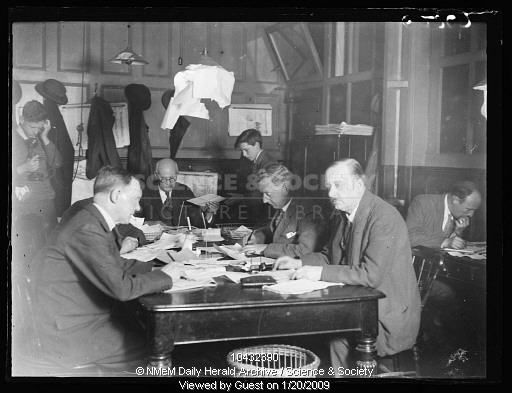
The Daily Herald sub editors' room in about 1928. From the Daily Herald Archive
In 1938 he became Assistant News Editor. By 1941 he was News Editor.

Daily Herald telegraphy office in 1931
In the 1950s he acted as Night Editor responsible for '"putting the paper to bed" to ensure that the first editions came out the following morning. He then became an Assistant Editor, which he combined with the duties of Political Editor.
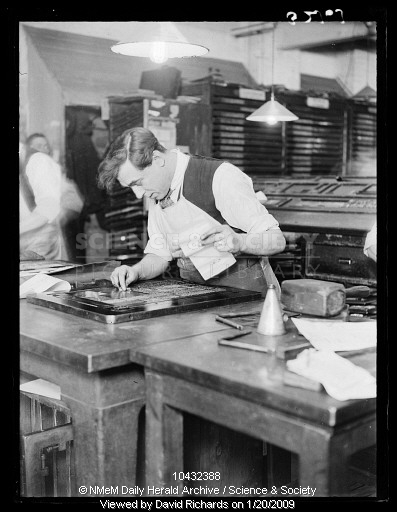
He retired in 1963. The paper closed the following year.
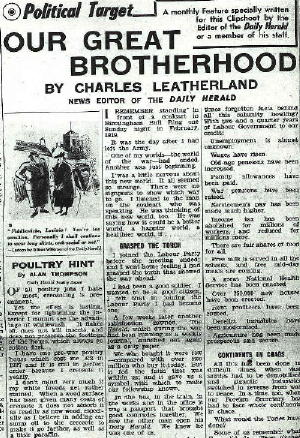
THE INKY WAY
In 1947 Leatherland wrote about his experiences as News Editor for the Inky Way Annual, a book about working in Fleet Street. The article provides an interesting and entertaining insight into a typical day in the life of a news editor on a daily newspaper :
"News editors go bald early, go to bed very late, and sleep with a telephone by their beds. The telephone is for the night staff to ring them five minutes after they have gone to sleep .. .. News editors have wide circles of friends. Cabinet ministers lunch with them. MPs sometimes naivlely address them as "sir". Master crooks often crave an audience. Very Important Persons say "come round and see me some time."
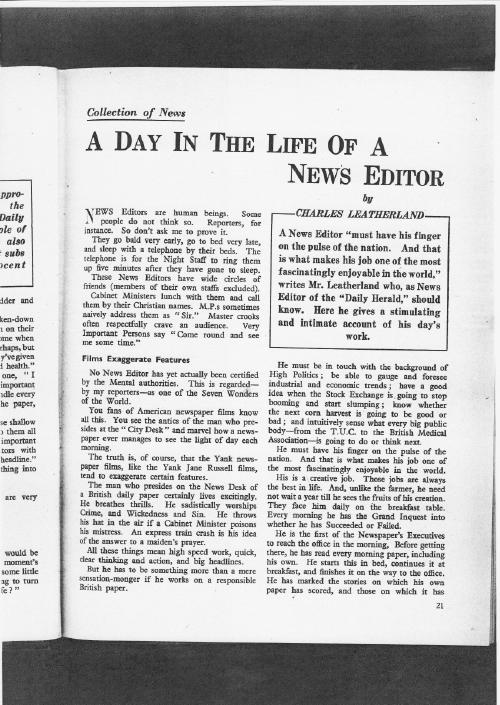
In a letter to The Independent from David Nathan following my grandfather's obituary, he said that :
"Those of us who were reporters on the Daily Herald when Charlie Leatherland was news editor will never forget the task he set us after he had met the Queen in the course of his official duties with Essex County Council in the late Fifties.
"As I was bending over the Queen's hand,' he told us, 'I noticed a slight plumpness. The Queen is pregnant. Confirm it and we have a world exclusive.'
'The Labour Party newspaper, the Daily Herald, did not have many royal contacts nor did our reporters possess the high esteem and confidence that the royal reporters of today enjoy. But we did our best.
'We rang the Palace Press Office to be met with denials; we rang bemused ladies-in-waiting and all kinds of aides and equerries who had hardly, if at all, heard of the Daily Herald, would not have known of the Queen's condition if she were pregnant and would not have told us if they had. We rang the royal doctors and chatted up as many of the royal grooms as we could find in the vicinity of the Royal Mews. All to no avail.
'But Charlie himself would tell of the great pregnancy scoop years later, adding, 'Of course I was right. Within two years Prince Andrew was born."
FREELANCE JOURNALIST
In the late 1920s and early 1930s, Leatherland wrote for other newspapers and magazines. His freelance work included a weekly political gossip column for the Sunday Dispatch and a weekly article in the popular John Blunt magazine.
He used to rent a tiny studio room in the Russell Hotel in Bloomsbury hotel on a Friday evening and stay there all night writing these articles.
My mother told that he sometimes wrote under the psuedonym of "Charles Morgan" so that his employers at the Daily Herald would not find out that he was also writing for rival papers, although I have not found evidence of this.
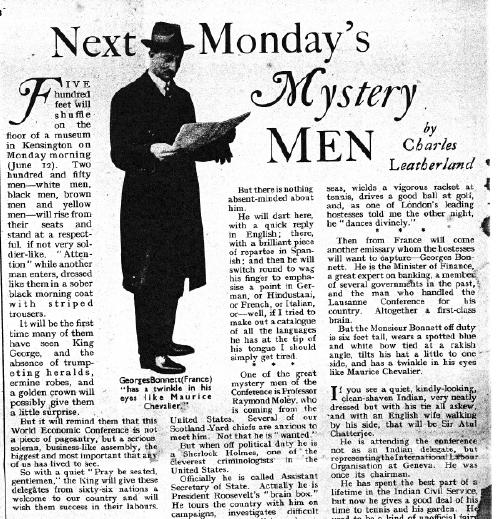
Article in The Passing Show magazine June 1933